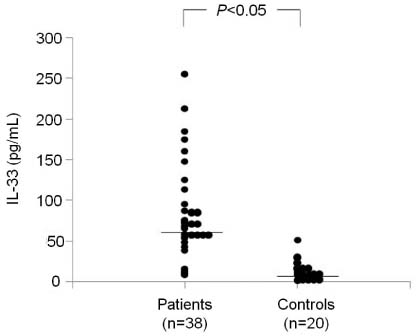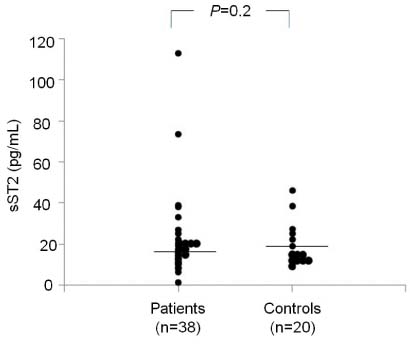Pediatr Allergy Respir Dis.
2012 Dec;22(4):383-389.
Increased Nasal Interleukin-33 in the Infants with Acute Respiratory Syncytial Virus Bronchiolitis
- Affiliations
-
- 1Department of Pediatrics, Catholic University of Daegu School of Medicine, Daegu, Korea. hlchung@cu.ac.kr
Abstract
- PURPOSE
Interleukin (IL)-33, a member of the IL-1 cytokine family, is considered to be important for innate-type mucosal immunity of the lung and also has been suggested to induce Th2-type immune responses. We aimed to investigate if IL-33 is involved in airway inflammation due to respiratory syncytial virus (RSV) infection in young children.
METHODS
Thirty-eight infants (< or =24 months of age) admitted with their first episode of RSV bronchiolitis were enrolled in the study. Atopy was defined by having at least 1 allergen-specific immunoglobulin E (IgE), positive result to skin prick test, or high serum IgE levels. The patients were assessed to have severe symptoms when they had > or =2 of the following clinical findings: hypoxemia (<92% oxygen saturation), rapid breathing (and/or lower chest wall indrawing), and >7 days of hospital stay. The levels of IL-33 and the IL-33 receptor (sST2) were measured using enzyme-linked immunosorbent assay in nasal secretion samples collected from the patients on admission and compared with 20 age-matched controls. We also investigated the levels of IL-33 and sST2 in relation to the atopic status and symptom severity of the patients.
RESULTS
Nasal IL-33 levels in the patients with acute RSV bronchiolitis were significantly increased (P<0.05), but sST2 showed no difference compared to the controls. Neither IL-33 nor sST2 showed significant difference in relation to the atopic status or severity of symptoms.
CONCLUSION
Our study showed significantly increased IL-33 in the nasal secretions of the young infants admitted with acute RSV bronchiolitis and suggests that IL-33 is involved in the pathogenesis of RSV-induced airway inflammation.
Keyword
MeSH Terms
Figure
Reference
-
1. Schmitz J, Owyang A, Oldham E, Song Y, Murphy E, McClanahan TK, et al. IL-33, an interleukin-1-like cytokine that signals via the IL-1 receptor-related protein ST2 and induces T helper type 2-associated cytokines. Immunity. 2005. 23:479–490.
Article2. Oboki K, Ohno T, Kajiwara N, Arae K, Morita H, Ishii A, et al. IL-33 is a crucial amplifier of innate rather than acquired immunity. Proc Natl Acad Sci U S A. 2010. 107:18581–18586.
Article3. Chow JY, Wong CK, Cheung PF, Lam CW. Intracellular signaling mechanisms regulating the activation of human eosinophils by the novel Th2 cytokine IL-33: implications for allergic inflammation. Cell Mol Immunol. 2010. 7:26–34.
Article4. Pecaric-Petkovic T, Didichenko SA, Kaempfer S, Spiegl N, Dahinden CA. Human basophils and eosinophils are the direct target leukocytes of the novel IL-1 family member IL-33. Blood. 2009. 113:1526–1534.
Article5. Suzukawa M, Koketsu R, Iikura M, Nakae S, Matsumoto K, Nagase H, et al. Interleukin-33 enhances adhesion, CD11b expression and survival in human eosinophils. Lab Invest. 2008. 88:1245–1253.
Article6. Oboki K, Nakae S, Matsumoto K, Saito H. IL-33 and Airway Inflammation. Allergy Asthma Immunol Res. 2011. 3:81–88.
Article7. Stolarski B, Kurowska-Stolarska M, Kewin P, Xu D, Liew FY. IL-33 exacerbates eosinophil-mediated airway inflammation. J Immunol. 2010. 185:3472–3480.
Article8. Iwahana H, Hayakawa M, Kuroiwa K, Tago K, Yanagisawa K, Noji S, et al. Molecular cloning of the chicken ST2 gene and a novel variant form of the ST2 gene product, ST2LV. Biochim Biophys Acta. 2004. 1681:1–14.
Article9. Tago K, Noda T, Hayakawa M, Iwahana H, Yanagisawa K, Yashiro T, et al. Tissue distribution and subcellular localization of a variant form of the human ST2 gene product, ST2V. Biochem Biophys Res Commun. 2001. 285:1377–1383.
Article10. Iwahana H, Yanagisawa K, Ito-Kosaka A, Kuroiwa K, Tago K, Komatsu N, et al. Different promoter usage and multiple transcription initiation sites of the interleukin-1 receptor-related human ST2 gene in UT-7 and TM12 cells. Eur J Biochem. 1999. 264:397–406.
Article11. Oboki K, Ohno T, Kajiwara N, Saito H, Nakae S. IL-33 and IL-33 receptors in host defense and diseases. Allergol Int. 2010. 59:143–160.
Article12. Walzl G, Matthews S, Kendall S, Gutierrez-Ramos JC, Coyle AJ, Openshaw PJ, et al. Inhibition of T1/ST2 during respiratory syncytial virus infection prevents T helper cell type 2 (Th2)- but not Th1-driven immunopathology. J Exp Med. 2001. 193:785–792.
Article13. Mathisen M, Strand TA, Sharma BN, Chandyo RK, Valentiner-Branth P, Basnet S, et al. Clinical presentation and severity of viral community-acquired pneumonia in young Nepalese children. Pediatr Infect Dis J. 2010. 29:e1–e6.
Article14. Kin Key N, Araujo-Neto CA, Nascimento-Carvalho CM. Severity of childhood community-acquired pneumonia and chest radiographic findings. Pediatr Pulmonol. 2009. 44:249–252.
Article15. Yagami A, Orihara K, Morita H, Futamura K, Hashimoto N, Matsumoto K, et al. IL-33 mediates inflammatory responses in human lung tissue cells. J Immunol. 2010. 185:5743–5750.
Article16. Kondo Y, Yoshimoto T, Yasuda K, Futatsugi-Yumikura S, Morimoto M, Hayashi N, et al. Administration of IL-33 induces airway hyperresponsiveness and goblet cell hyperplasia in the lungs in the absence of adaptive immune system. Int Immunol. 2008. 20:791–800.
Article17. Lloyd CM. IL-33 family members and asthma - bridging innate and adaptive immune responses. Curr Opin Immunol. 2010. 22:800–806.
Article18. Prefontaine D, Lajoie-Kadoch S, Foley S, Audusseau S, Olivenstein R, Halayko AJ, et al. Increased expression of IL-33 in severe asthma: evidence of expression by airway smooth muscle cells. J Immunol. 2009. 183:5094–5103.
Article19. Prefontaine D, Nadigel J, Chouiali F, Audusseau S, Semlali A, Chakir J, et al. Increased IL-33 expression by epithelial cells in bronchial asthma. J Allergy Clin Immunol. 2010. 125:752–754.
Article20. Kropf P, Herath S, Klemenz R, Muller I. Signaling through the T1/ST2 molecule is not necessary for Th2 differentiation but is important for the regulation of type 1 responses in nonhealing Leishmania major infection. Infect Immun. 2003. 71:1961–1971.
Article21. Hazlett LD, McClellan SA, Barrett RP, Huang X, Zhang Y, Wu M, et al. IL-33 shifts macrophage polarization, promoting resistance against Pseudomonas aeruginosa keratitis. Invest Ophthalmol Vis Sci. 2010. 51:1524–1532.
Article22. Garlanda C, Anders HJ, Mantovani A. TIR8/SIGIRR: an IL-1R/TLR family member with regulatory functions in inflammation and T cell polarization. Trends Immunol. 2009. 30:439–446.
Article23. Oshikawa K, Yanagisawa K, Tominaga S, Sugiyama Y. Expression and function of the ST2 gene in a murine model of allergic airway inflammation. Clin Exp Allergy. 2002. 32:1520–1526.
Article24. Oshikawa K, Kuroiwa K, Tago K, Iwahana H, Yanagisawa K, Ohno S, et al. Elevated soluble ST2 protein levels in sera of patients with asthma with an acute exacerbation. Am J Respir Crit Care Med. 2001. 164:277–281.
Article25. Hayakawa H, Hayakawa M, Kume A, Tominaga S. Soluble ST2 blocks interleukin-33 signaling in allergic airway inflammation. J Biol Chem. 2007. 282:26369–26380.
Article
- Full Text Links
- Actions
-
Cited
- CITED
-
- Close
- Share
- Similar articles
-
- Relationship between Atopic Status and Immunoregulatory Cytokines in Respiratory Syncytial Virus Bronchiolitis
- The Effect of Respiratory Syncytial Virus Infection on the Production of Interleukin-5 and RANTES in Bronchiolitis
- Clinical and epidemiologic features of respiratory sybcytial virus infection
- Respiratory Syncytial Virus Infection Complicated by Extrapulmonary Manifestations
- The Relationship between the Time of First Respiratory Syncytial Virus Bronchiolitis and Later Wheezing and Asthma Development



